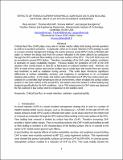Effects of porous superhydrophilic surfaces on flow boiling critical heat flux in IVR accident scenarios
Author(s)
Atkhen, Kresna; Buongiorno, Jacopo; Azizian, Mohammad Reza; McKrell, Thomas J.
DownloadNURETH-16-Paper-(03 24 15) (RA) (JB rev).pdf (1.059Mb)
OPEN_ACCESS_POLICY
Open Access Policy
Creative Commons Attribution-Noncommercial-Share Alike
Terms of use
Metadata
Show full item recordAbstract
Critical Heat Flux (CHF) plays a key role in nuclear reactor safety both during normal operation as well as in accident scenarios. In particular,when an in-vessel retention (IVR) strategy is used as a severe accident management strategy, the reactor pressure vessel (RPV) cavity is flooded with water, to remove the decay heat from the corium relocated in the lower plenum by conduction through the RPV wall and flow boiling on the outer surface of the RPV. The CHF limit must not be exceeded to prevent RPV failure.Therefore, knowledge of the CHF under realistic conditions is necessary to assess coolability margins. Previous studies for prediction of CHF in the IVR situation were mostly based on data for as fabricated un-oxidized stainless steel. However, the RPV is made of low carbon steel and its surface has an oxide layer that results from pre-service heat treatment as well as oxidation during service. This oxide layer introduces significant differences in surface wettability, porosity, and roughness in comparison to an un-oxidized stainless steel surface. In this study, test heaters were fabricated out of RPV low carbon steel, pre-oxidized in a controlled high temperature wet air environment, which emulates the surface oxides present on the outer surface of the actual RPV; the heaters were then tested in a flow boiling loop designed specifically for the IVR conditions. Up to 70% enhancement in CHF value was observed for the oxidized in low carbon steel in comparison to the stainless steel.
Date issued
2015Department
Massachusetts Institute of Technology. Department of Nuclear Science and EngineeringJournal
International Topical Meeting on Nuclear Reactor Thermal Hydraulics 2015 (NURETH-16)
Publisher
American Nuclear Society ( ANS )
Citation
Azizian, Reza; McKrell, Thomas; Atkhen, Kresna and Buongiorno, Jacopo. "Effects of porous superhydrophilic surfaces on flow boiling critical heat flux in IVR accident scenarios." International Topical Meeting on Nuclear Reactor Thermal Hydraulics 2015 (NURETH-16), August 30-September 4 2015, Chicago, Illinois, American Nuclear Society (ANS), 2015. © 2015 American Nuclear Society (ANS)
Version: Author's final manuscript
ISBN
9781510811843